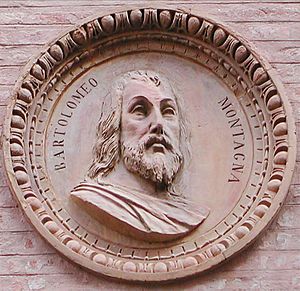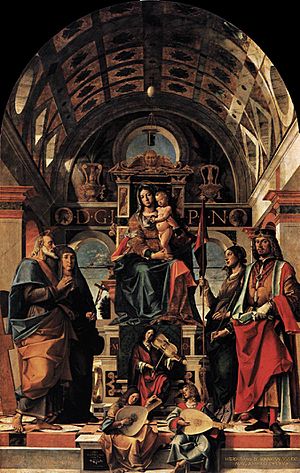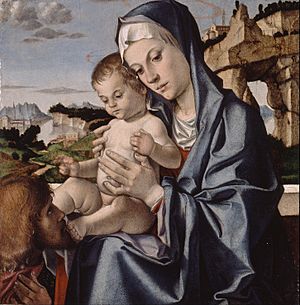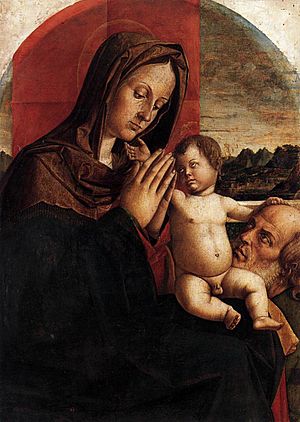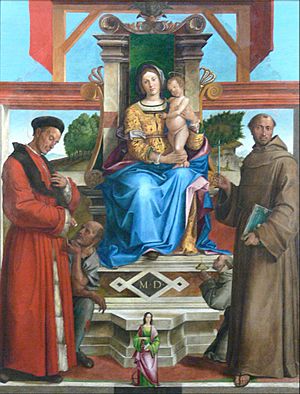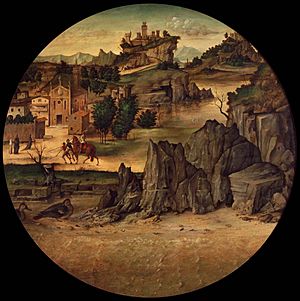Bartolomeo Montagna facts for kids
Bartolomeo Montagna (born around 1450, died October 11, 1523) was an Italian painter during the Renaissance period. He mostly worked in a city called Vicenza in Italy. He also created art in other Italian cities like Venice, Verona, and Padua.
Montagna is especially famous for his many paintings of the Virgin Mary, often called "Madonnas." His artworks are known for showing figures that look soft and for featuring interesting marble buildings. Many art experts believe he was greatly influenced by the famous painter Giovanni Bellini. Montagna's son, Benedetto Montagna, also became a successful artist known for his engravings.
Contents
Life of Bartolomeo Montagna
Bartolomeo Montagna was born Bartolomeo Cincani, but he later changed his name to Montagna. He was likely born around 1450. His family originally came from Brescia, Italy, and later settled in Vicenza by 1460. His brother, Baldissera, was a goldsmith.
Montagna lived in Vicenza for most of his life. He bought a house there in 1484, right across from the Church of San Lorenzo. From 1469 to 1475, Montagna lived in Venice. After that, he returned to Vicenza and began his career as a painter. In 1509, he moved to Padua, probably because of a war happening in Vicenza. He stayed in Padua until 1514.
We don't know the name of his wife, but they had three sons. One of his sons, Benedetto Montagna, became a well-known artist who made engravings. Bartolomeo Montagna passed away on October 11, 1523. He left most of his belongings and his art business to his son, Benedetto.
Montagna's Art Career
Since we don't know Montagna's exact birthdate, it's hard to say exactly when he started his art career. Throughout his life, his paintings were known for being simple and serious. The people in his paintings often look calm and solid.
Early Paintings (1480s–1499)
Montagna's first known art job was for two paintings in Venice. These paintings were supposed to show scenes from the Great Flood and other parts of the Bible. Sadly, they were destroyed in a fire in 1485, so we can't see them today.
His oldest painting that still exists is from September 1487. It's called The Virgin and Child with Saint Sebastian and Roch. This small painting was made for private use. It shows the figures inside a marble area with a landscape from Vicenza in the background. This painting also shows Montagna's first use of a special type of marble called trachyte. This unique marble texture appears in most of his artworks.
Around this time, he also painted a large altarpiece for San Bartolomeo in Vicenza. In 1491, he painted an altarpiece and frescos (wall paintings) for a church in Verona. These wall paintings showed scenes from the life of St. Blaise. These works are known for their realistic, thin figures.
Montagna's early paintings often use trachyte marble in the architecture. He also had a special way of painting the Virgin Mary's hand, with her middle and ring fingers touching and separated from the others. His early works are usually balanced, well-organized, and have even lighting. The figures in them often look like solid, plastic forms.
Middle Period (1499–1507)
An altarpiece from 1499, called Virgin and Child with Four Saints and Music-making Angels, is seen by many art experts as a turning point in Montagna's style. His art started to use warmer and richer colors. This painting shows an outdoor scene and is similar to a work by Giovanni Bellini.
In 1500, Montagna finished a painting called a Pieta for a church. This painting shows the Virgin Mary holding the dead body of Christ. It also features Mary Magdalen kissing his feet, along with St. John and St. Joseph. This painting uses soft colors and smooth lines, which was a growing trend in Renaissance art.
Around this time, the Bishop of Vicenza asked Montagna to create a painting for the Cathedral of Vicenza. This artwork was lost after 1779. In 1504, Montagna traveled to Verona to paint frescos for a chapel, showing many scenes of St. Blaise. Because these were so successful, he was asked in 1507 to paint an altarpiece for another church in Verona. This painting is known for its bright architecture, unusual throne, and fancy clothes.
Montagna's style during this time is known for being unique, even though other artists were adopting a calmer style. His paintings often had bright colors, fancy buildings, detailed clothing, and sharp angles. But even with these sharp details, the people in his paintings often looked fuller and softer.
Later Paintings (1507–1522)
The last known dated painting by Montagna is from 1507. However, many paintings have been dated by experts to after this time. Art from the last 15 years of his life is sometimes seen as a slight decline from his best work.
His style changed noticeably during the years he spent in Padua (1509-1514). These paintings show more landscapes, sunsets, and warm colors mixed with his usual architectural style. His art became less consistent, but often included fuller figures, deep shadows, and fewer sharp angles. In 1517, Montagna returned to Vicenza. In 1522, he was asked to paint an altarpiece for a church. This painting shows the Virgin Mary, the Child Jesus, three shepherds, and St. Joseph and St. Sebastian.
Artistic Influences
There are no written records about how Montagna learned to paint, but many people have ideas about who influenced him. Some historians believe he learned from Andrea Mantegna. However, it's generally agreed that Montagna was influenced by other famous painters like Giovanni Bellini, Antonello da Messina, and Alvise Vivarni.
Most experts agree that Bellini had the biggest influence on Montagna's art. Montagna's use of detailed and angular clothing in his paintings is similar to Vivarni's work. Paintings inspired by Antonello often have rounded shapes, while those inspired by Bellini feature thinner and sharper figures. Montagna's move to brighter and richer colors later in his life is also thought to be because of Bellini's influence. It was common for artists during the Italian Renaissance to borrow ideas and compositions from each other.
Where to See Montagna's Art
Many museums and art collections around the world have paintings by Bartolomeo Montagna. Here are some of the places where you can find his works:
- Rijksmuseum, Amsterdam
- Walters Art Museum, Baltimore
- Museo della Certosa di Pavia
- Musei Civici, Belluno
- Accademia Carrara, Bergamo
- Berlin State Museums, Berlin
- Fitzwilliam Museum, Cambridge
- Walker Art Gallery, Liverpool
- Courtauld Gallery, London
- Pavia Civic Museums, Pavia
- National Gallery, London
- Museo Poldi Pezzoli, Milan
- Pinacoteca di Brera, Milan
- Metropolitan Museum of Art, New York City
- National Gallery of Canada, Ottawa
- Ashmolean Museum of Art and Archaeology - University of Oxford, Oxford
- Louvre, Paris
- Musée des Beaux-Arts, Strasbourg
- National Museum of Western Art, Tokyo
- Museo Correr, Venice
- Gallerie dell'Accademia, Venice
- Musei Civici, Verona
- Vicenza Cathedral, Vicenza
- Musei Civici, Vicenza
- National Gallery of Art, Washington, D.C.
- Worcester Art Museum, Worcester, MA
See also
 In Spanish: Bartolomeo Montagna para niños
In Spanish: Bartolomeo Montagna para niños


